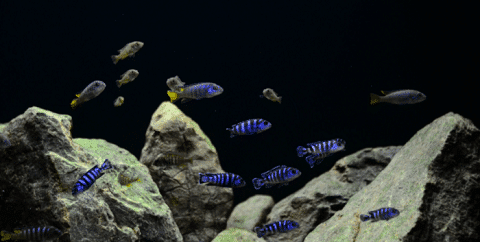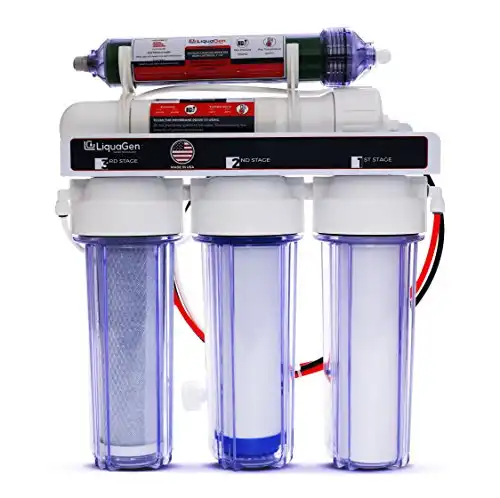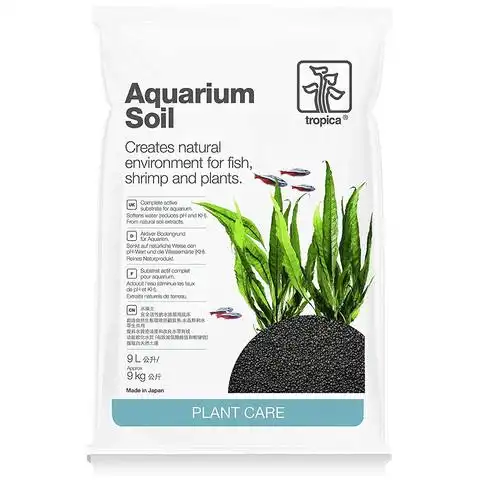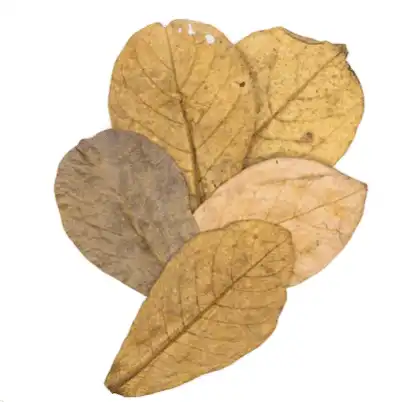Thank you for visiting! By the way… any links on this page that lead to products on Amazon and other stores/partners are affiliate links Aquarium Store Depot earns a commission if you make a purchase.
In this blog, I’ve covered a lot about maintaining water quality and ideal tank water requirements for your fish. But, today I’ll talk about rather serious issues, i.e., dealing with water hardness. We’ll also discuss general hardness gh and carbonate hardness. Also, how does hard water affect your aquatic plants and livestock.
Before we learn how to soften aquarium water, let’s learn what is water hardness.
What Is Hardness?
We’re not diving into the scientific definition, so, in simple words, water hardness is the number of dissolved minerals, such as Calcium ions and Magnesium ions in water. Hard water feels slimy on your hands even after washing with soap. Therefore, you end up using more soap or detergent to clean things.
Hard water also leaves solid deposits of Calcium carbonate on your utensils and lowers the efficiency of water heaters and other equipment, ultimately reducing the life of your kitchen utensils. In short, hard water has high mineral content while soft water has low mineral content that does not affect your aquatic friends so much.
As surprising as it sounds, hard water possesses some real benefits for humans. Because humans, in general, require mineral content to remain healthy and hard water provides just the right traces of Calcium and magnesium in the diet.
Hardness And pH level In Fish Tanks
Water hardness is often ignored by many aquarists. However, it’s essential to maintain water hardness in your aquarium as it is closely related to pH levels in your aquarium water. Therefore, many fish experts suggest using water conditioners to adjust the mineral content in home aquariums.
That’s because a wide number of fish species cannot survive hard water, causing them to fall ill and die. Sometimes, the tap water is slighter hard, and in some places, it is soft. The water hardness or water softness depends on the place you live in.
As a rule of thumb, if you live in areas with limestone, the water will be hard. If your tap water comes from rivers and lakes, the water will be soft because it has low mineral content.
How Does Hardness Affect Your Fish Tank
Hard water directly influences pH levels in your fish tank. The minerals in hard water make the tank water more alkaline and acidic, ultimately affecting the overall health and well-being of your soft water fish species.
Many aquarium fish species have always lived in soft water, so they don’t adapt well to hard water and it may lead to many health issues. Additionally, hard water also interrupts the osmoregulatory process1, where they maintain a balance between salt and water inside their bodies, leading to stress and illness.
As far as breeding is concerned, even hard water fish species find it hard to breed in hard water. Therefore, experts suggest changing hard water to soft water to stimulate spawning.

Furthermore, if you have tank decorations, you’ll always notice limescale deposits on equipment and other tank decors, reducing the efficiency and working mechanisms of heaters and aquarium filters leading to an unhealthy tank environment.
Fun Fact: Most fish species are not soft water fish and thrive in hard water. For example, African Cichlids, Paradise fish, prefer slightly hard, alkaline water. In a saltwater aquarium, water is naturally hard. Some fish like Discus fish, need very soft water.
General Hardness GH vs. Carbonate Hardness
The measures of concentration of Calcium and magnesium ions along with carbonate and bicarbonate ions in water are called general hardness and carbonate hardness.
General Hardness GH
The concentration of Magnesium and Calcium ions in the water is termed General hardness. In my earlier posts, you must have noticed units such as ppm (parts per million) or DH (Degrees hardness). So, ppm and DH are the units of General hardness where 1°dH indicates 10 mg of calcium oxide (CaO) per liter of water.
The general hardness (GH) can have an adverse effect on the health and well-being of your aquatic pets and aquarium plants as they have different hard water preferences.
Carbonate Hardness KH
The concentration of Carbonate ions and Bicarbonate dissolved in the water is termed Carbonate hardness. Carbonate hardness turns the fish tank water alkaline and may resist changes in the pH levels of your aquarium water.
Low KH can result in fluctuating pH levels, which significantly impact your aquarium life, whereas high KH results in a more stable pH.
In conclusion, General hardness is easier to adjust than carbonate hardness.
Changing GH And KH In Your Fish Tank
There are different treatments to control GH and KH in aquarium water. First of all, experts suggest using water conditioners, salt, water softening pillow, RO water, etc.
We will discuss how to treat GH and KH and how to soften your aquarium water later, but first, let’s discuss how hard water and soft water are distributed in the United States.
The map above indicates the concentration of water hardness in the USA. The red areas indicate hard water, and the purple areas (East coast outside of Florida and North East coasts) indicate soft water. Knowing the hardness of where you live helps to naturally pick out your fish. For example, if you live in North Carolina, you are best off with software fish like many freshwater community fish, while if you live in Texas, you will do best with African cichlids as they prefer hard water.
7 Ways On How To Soften Aquarium Water
Now that we laid out the foundation, let’s talk about the 7 ways to soften our water.
1. RO Filter
Reverse osmosis filters are commonly used in the aquarium hobby to purify water for freshwater and marine aquariums. RO filter works to soften aquarium water by removing dissolved minerals and solids from the water and only letting water molecules pass through.
The surprising part of using RO filters is their ability to re-mineralize the water after de-mineralizing it. Of course, water free of all minerals can be detrimental to your fish. Therefore, there’s a characteristic named “blank slate” of RO water, allowing you to add your preferred re-mineralizing products to achieve your desired KH, GH, and pH levels.
If you own larger tanks, a reverse osmosis unit is the best investment you can make. If you are trying to keep a saltwater tank, consider an RODI filter instead.
Best Value
A complete 5 stage RODI unit without the excessive price
2. Distilled water
Distilled water is devoid of all the impurities and minerals as it has been boiled into vapor and cooled to form liquid again. This extreme process of vaporizing the water and turning it back to liquid results in 100% purified water that removes all the minerals from it, making GH absolutely zero. Also, it is free of chlorine, chloramines, soluble heavy metal ions, and other chemicals.
It is readily available everywhere—in pharmacies, grocery stores, and local pet shops. However, if you have large breeding tanks or large fish tanks, the regular use of distilled water can be heavy on the pocket.
How to use distilled water in your aquarium
- I always suggest mixing regular aquarium water with distilled water and adjusting the softness or hardness, respectively. And perform regular water changes using the same ratio of distilled water and aquarium water to decrease the water hardness over time.
- Before mixing aquarium water and distilled water and before adding it to the fish tank, double-check the water parameters.
- Use salts and other remineralizing products from the market to make sure your aquarium water gets all the right minerals it needs.
3. Rainwater

The best and most affordable option that involves no additional cost and maintenance is using rainwater to soften aquarium water.
The perfect advice is to do all water changes using rainwater. But, the question arises, how do I know if rainwater is soft?
Absolutely right! You don’t. Hence, you can always collect rainwater to test it later to determine the levels of GH and KH. However, be informed that rainwater is naturally and usually soft because it has zero traces of dissolved minerals, including Calcium and Magnesium.
However, if you find out the collected rainwater is way too soft for your ideal water parameters, you can always mix it up with tap water – just make sure you dechlorinate the water!
Practice caution
While softening aquarium water with rainwater, practice caution as it can collect many pollutants from the environment and may pollute your tank as well. Besides, collect rainwater in clean containers or barrels to prevent contaminants from entering into your aquarium water. Lastly, always test collect rainwater before adding it to your aquarium as it can sometimes be slightly acidic water, harmful for your fish.
4. Peat Moss

If you’re looking for an all-natural, organic option for softening aquarium water, adding peat moss to your aquarium should be your best bet. Peat moss releases humic substances and tannins that reduce the general hardness and Carbonate hardness of aquarium water. This also results in low pH levels and makes the water more acidic. It is considered a “natural” chemical filtration media that leads to softer water.
If you have blackwater fish in your tank, adding peat moss gives your water a brownish hue that mimics the natural environment of your fish to thrive in such water conditions.
How to use peat moss to soften aquarium water
- Soak or boil peat moss for a few hours before adding it to the aquarium water to clean any impurities and toxins.
- Use a mesh bag or nylon stocking to place the peat moss. It is recommended to position the peat moss inside the filter, so water flows freely through it.
- Always check and monitor the pH level, GH, and KH after you add it to ensure water chemistry is within safe levels.
- I recommend replacing peat moss every other month to maintain efficiency.
- While performing water changes, always use a mix of tap water and soft water in the form of RO, rainwater, etc.
- To remove some of the color of peat moss, add activated carbon in the water filter to clear up the water.
Aqua Soil
A top grade planted tank substrate from Europe. More natural looking than ADA Soil
If you have a heavily planted aquarium, consider using aqua soil to create and maintain ideal water conditions for aquatic plants. Aqua soil uses natural materials to lower the carbonate hardness, reducing the pH levels in water to make it more acidic and soft.
Many aquarists, including myself, are raving fans of aqua soil for planted tanks because they are rich with nutrients, including nitrogen, phosphorus, and other elements needed for plant growth.
However, if you’re setting up your tank with aqua soil for the first time, be careful of Ammonia leaching. If this happens, avoid adding fish to your tank until the ammonia levels are under safe ranges.
Indian Almond Leaves
Also, an ideal natural solution for brackish water fish species, Indian almond leaves are used to soften aquarium water. These dried leaves are most popularly used in betta fish tanks or shrimp tanks. They release tannins and humic substances to soften aquarium water and lower its pH.
These leaves can be added to your aquarium to help promote a natural habitat for bettas, shrimp, and other soft-water loving fish. Betta breeders can use these leaves to help encourage breeding behavior.
Not only does it soften aquarium water, but it also provides natural shelter for your fish to flee from stress and predators effectively.
How to add Indian almond leaves to soften aquarium water
The process is straightforward.
- Take dry and brown Indian Almond leaves and rinse them thoroughly to remove pollutants and get rid of insects.
- Add a few leaves to your tank and let them settle down to the bottom.
- After a week or so, test your water for hardness. Needless to say, the water hardness level should go down!
Driftwood
Driftwood is also a natural alternative to soften aquarium water. Just like peat moss, driftwood also releases tannic acid that boosts fish immunity and fights against fungal infections.
Editor's Choice
Manzanita offers it all. Great shape, low tannins, quick to water log and reasonably priced. It's the ultimate driftwood!
However, driftwood impacts pH more than KH. Also, your tank water needs to be carefully monitored for fungal growth and parasites if the driftwood is contaminated or not clean enough.
FAQs
How do I lower the hardness of my aquarium water?
You can lower the water hardness in your aquarium water by adding water conditioners, salts, water softening pillows, RO filters, and much more. Whatever you do, make sure you perform regular water changes and monitor the water parameters to track water hardness regularly.
Is it okay to put fish in hard water?
Yes, there are a variety of tropical fish well-suited for all types of tanks, including hard water tanks.
How do I make my aquarium water soft?
You can add natural and organic matter such as Indian almond leaf, water-softening pillows, distilled water mixed with tap water, and much more to soften aquarium water easily.
How do I lower the hardness in my aquarium naturally?
To lower the hardness in your aquarium naturally, you need to add natural elements such as Rainwater, Indian almond leaf, peat moss, and driftwood. These options soften water through natural means and keep your fish healthy and happy.
Can I use baking soda to soften aquarium water?
No, fish experts do not recommend using baking soda to soften aquarium water as it raises the carbonate’s highness and pH levels and does quite the opposite of softening water.
Is it safe to use a water softener in a fish tank?
Yes, it’s absolutely safe to use water softeners in a fish tank. Since most water softeners are organic and natural and provide the right balance of dissolved mineral levels, the fish remain healthy and thrive in your home aquariums.
Final Thoughts
Water hardness is one of the most critical problems in the aquarium world. But, not anymore! Because now you know how to soften aquarium water without compromising the health of your fish and breaking the bank.
For larger tanks, invest in RO filters. For heavily planted aquariums, go for Aqua soils, and for brackish water fish species tanks, always choose Indian leaves and Peat moss.
- About the Author
- Latest Posts
I’m thrilled that you found Aquarium Store Depot! Here you’ll find information on fish, aquariums, and all things aquatics related. I’m a hobbyist (being doing this since I was 11) and here to help other hobbyists thrive with their aquariums! I adhere to a high quality Editorial Process and Review products with real life field usage and practical analysis.









